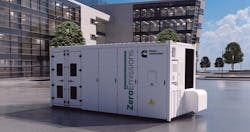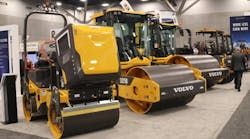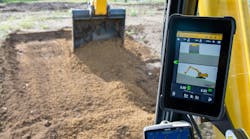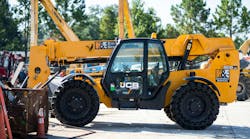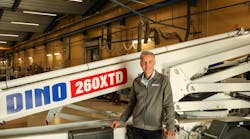When one thinks of Genie, one usually thinks of aerial work platforms and telehandlers.
But Terex’s light towers are also manufactured and marketed by its aerial work platforms division, more popularly known as Genie.
The RL-4 brand is long known for its use on construction sites, highway construction zones, oil field applications, sporting and other special events. The company has made some significant improvements to the machine.
“With the redesign on the RL4, we focus on three main things,” says Marie Engstrom, product manager for Terex light towers and Genie portable products. “The first is efficiency, the second is performance, and the third one is service.”
In terms of efficiency, the new vertical mast simplifies and cuts set-up time by using only one winch for quick operation. A smaller footprint makes it possible to fit 17 units on a 48-foot trailer instead of 10 units with the previous model, resulting in significant cost savings in deliveries from the factory to the rental center, as well as from the rental center to a jobsite where multiple light towers are required.
The previous RL-4 light tower had a 30-gallon tank, compared to 45-gallons on the new version, increasing run time from approximately 60 hours to about 90 hours.
“That was the second part of our focus on the redesign,” Engstrom says. “There are a lot of new elements to talk about the performance. The first, we were able to get the biggest fuel tank in the class in this new RL. It’s a 45-gallon fuel tank, up from our previous model that had a 30-gallon fuel tank; that equates to a 90-hour run time. Thinking about units out in remote locations, this means the unit is going to run longer. We don’t have to refuel it as frequently. So if a mining site or remote oil and gas application has a few dozen light towers out there, they can run maybe a whole week without someone having to run out and refuel it. So again another point where we’re adding value to our customers, they’re saving money by not having to go out and refuel as often.”
Remote sites are common applications for the RL-4 in addition to construction sites and highway construction zones.
“Oil and gas is a big area for the RL, we send a lot of light towers to Texas and down South where there’s a lot of drilling, also up North to Alberta and the Dakotas,” says Engstrom. “Other applications that we see are community and sporting events, car races and NASCAR, and when they get light towers they get dozens at a time. They are used a lot in concerts and other events, often used for providing security in parking lots.”
The RL-4 has an optional autostart feature that enables the user to begin operation with a photocell or timer. The unit’s Kohler 10.7-horsepower liquid-cooled engine is quieter than the previous version and has been engineered for longer service intervals, enabling the unit to go about 500 hours between oil changes rather than 400 as in the past. In keeping with the improved service aspect of the machine is a redesigned engine compartment where all parts and service points are more easily accessible.
Genie also changed to a polymer cover. “There are a few reasons we chose to do that,” says Engstrom. “The first is that we know these are often used in harsh locations and this cover is dust resistant and rust resistant. The unit is going to look newer longer, so your investment, esthetically speaking, is going to look better.”
The lights are adjustable. “You can point the light where you want it to go before you raise it up to a full height,” says Engstrom. “You can rotate them using these handles, full rotation, but the lights are set when you raise them.”
Terex has operated in the Rock Hill facility for 15 years, since acquiring Amida, which made light towers at the facility before being acquired by Terex. At the Rock Hill site, Genie also produces its popular TZ-34/20 trailer-mounted boomlift, a rugged lift that is lightweight enough to use on lawns, slate or gymnasium floors. It features an extension boom with a self-leveling platform, a variable-speed control system, and hydraulic outriggers with outrigger interlocks and illuminated outrigger indicators. It has a platform height of 34 feet, a working height of 40 feet and an up-and-over clearance of 16 feet, 1 inch.
The Rock Hill facility also serves as a pre-delivery inspection point for Genie’s 5519, 1256, and 1544 telehandlers that are manufactured at Genie’s facility in Italy. Once they come to the United States, they are sent to Rock Hill, where the company does pre-delivery inspections on the units before they are sent on to the customer. Often the machines are modified according to customer request and painted different colors, also according to customer specifications. When I visited the plant I saw a large number of Genie telehandlers painted in Sunbelt’s distinctive green in preparation for delivery to the national company, based nearby in Fort Mill, S.C., also on the outskirts of Charlotte, N.C.
However, Genie keeps a considerable quantity of telehanders on hand at the Rock Hill facility so that it is able to fill customers’ orders quickly, rather than have to wait for the longer lead time for each order that would be required when including shipping time on the ocean and going through customs.
Meanwhile the company is ramping up production of light towers for the fall and winter seasons when shorter days call for more light.
